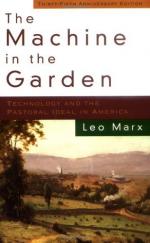
|
| Name: _________________________ | Period: ___________________ |
This test consists of 15 multiple choice questions and 5 short answer questions.
Multiple Choice Questions
1. In Jefferson's time, how did the eastern farmers come to see nature, as a result of their work?
(a) As a raw material.
(b) As a new nature.
(c) As an improved nature.
(d) As a domestic industry.
2. What was the opposite of Barlowe's experience in his travels?
(a) Sparse resources and unsafe territory.
(b) Storms and primitive land.
(c) Political intrigue.
(d) Rocky soil and harsh laws.
3. What economic consequence does the sentimental pastoral ideal engender?
(a) Tariffs on imported manufactured goods.
(b) Low taxes.
(c) Farm subsidies.
(d) Regulation of speculative investments.
4. What did Hawthorne describe in the piece Marx analyzed?
(a) Indian wars.
(b) A reverie in the woods.
(c) Living in the woods.
(d) A whale hunt.
5. What was nature's role supposed to be in the nation's future, by Jefferson's time?
(a) Virgin territory was going absorb all the overflowing east-coast cities.
(b) Natural resources were going to be a source of wealth for generations.
(c) Agriculture was going to supply the nation's wealth.
(d) Wilderness was going to redeem the nation's soul.
6. What threat to the country's moral superiority had developed by Jefferson's time?
(a) Public transit.
(b) Enclosure laws.
(c) Slavery.
(d) The end of slavery.
7. What does Marx say is the central theme of pastoral literature?
(a) The interruption of woodland peace.
(b) The imperative to transform nature.
(c) The futility of fighting nature.
(d) The desire to merge with nature.
8. When did Robert Beverly write his history of Virginia?
(a) 1703.
(b) 1620.
(c) 1690.
(d) 1607.
9. What did Jefferson want to keep in Europe?
(a) Manufacturing.
(b) Government.
(c) Slavery.
(d) Finance.
10. Why did Beverly feel as he did by the end of his work?
(a) He thought that the New World could improve the natives.
(b) He thought that the settlers and natives could work together.
(c) He thought the New World would improve the settlers.
(d) He saw a unique opportunity in the New World.
11. In what art does Marx see pastoral ideology contributing to a more realistic outcome for American society?
(a) Literature.
(b) Music.
(c) Sculpture.
(d) Painting.
12. What does Marx say is the leading image of industrialism?
(a) The steamship.
(b) The cotton gin.
(c) The steam locomotive.
(d) The factory.
13. How did Arthur Barlowe describe America?
(a) As a land of plenty.
(b) As a refuge from Europe.
(c) As a harsh land.
(d) As a tropical paradise.
14. What sources does Marx suppose Shakespeare read for 'The Tempest'?
(a) Accounts of African tribes.
(b) Accounts of travel to the Pacific islands.
(c) Accounts of travel to the New World.
(d) Accounts of travel to India.
15. When did the pastoral idea become part of American culture?
(a) At the Revolution.
(b) During the French Revolution.
(c) At the Industrial Revolution.
(d) At colonization.
Short Answer Questions
1. Where was Hawthorne when he wrote the piece Marx analyzed?
2. Which characters are engaged in the final struggle in Shakespeare's 'The Tempest'?
3. America was depicted as a paradise that was also what, in Marx's account?
4. What virtues would the Jeffersonian man strike a balance between?
5. What human structure did Barlowe describe America in terms of?
|
This section contains 512 words (approx. 2 pages at 300 words per page) |

|




